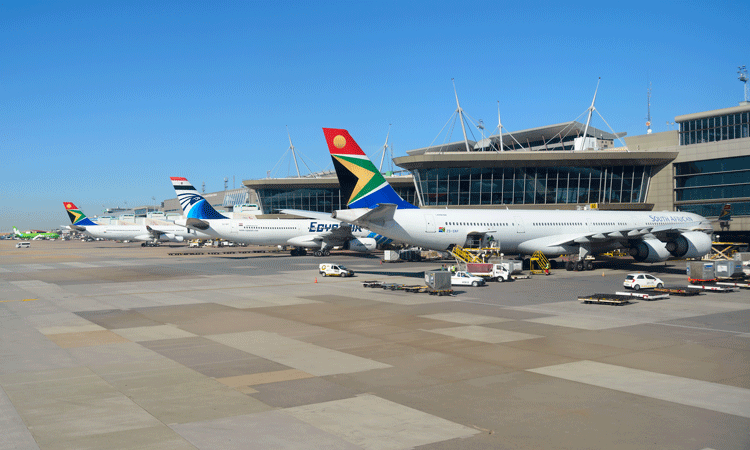Capacity constraints in a growing world: Understanding capacity challenges from an African mindset
- Like
- Digg
- Del
- Tumblr
- VKontakte
- Buffer
- Love This
- Odnoklassniki
- Meneame
- Blogger
- Amazon
- Yahoo Mail
- Gmail
- AOL
- Newsvine
- HackerNews
- Evernote
- MySpace
- Mail.ru
- Viadeo
- Line
- Comments
- Yummly
- SMS
- Viber
- Telegram
- Subscribe
- Skype
- Facebook Messenger
- Kakao
- LiveJournal
- Yammer
- Edgar
- Fintel
- Mix
- Instapaper
- Copy Link
Posted: 20 March 2024 | Ekelem Airhihen | No comments yet
Ekelem Airhihen, Assistant General Manager for the Federal Airports Authority for Nigeria (FAAN), discusses capacity challenges for airports across Africa. He gives an in-depth understanding of the challenges facing air traffic, including migration and sociological workforce issues.


An overview of air travel across African countries
Three issues will significantly affect the ability of African airports (Nigeria especially) to effectively manage capacity challenges – ownership, global trends and workforce issues. These issues are also mutually reinforcing and cannot be dealt with in isolation.
The outlook continues to be positive for airlines in Africa. The African Airlines Association (AFRAA), which is a trade association of airlines from the member states of the African Union, reported in September 2023 that traffic carried by African airlines in August 2023 had reached 98.4% of the 2019 level. It reported further that the total number of intercontinental routes operated by African airlines exceeded pre-COVID-19 levels since October 2022. Some major airports like Johannesburg, Nairobi, Addis Ababa, Lusaka, Cairo, Casablanca, Abidjan and Lome were reported to have either reached or exceeded pre-COVID levels for intra-African connectivity since December 2022.
The Airports Council International (ACI) in its advisory bulletin: ‘The Impact of Covid-19 on Airports and the path to recovery’, published on 6 October 2022, that there was strong demand for air travel amidst heightened macroeconomic risks. The report also stated further: ‘On the other hand, markets like Colombia, Mexico and Nigeria welcomed a surge in demand and exceeded their 2019 levels’.
The African continent offers a variety of experiences and opportunities and as such air travel plays a crucial role in facilitating travel and connectivity across the massive expanse of land covered by Africa. Some of the reasons why people travel in Africa are for tourism, business, humanitarian efforts, education and research, to visit family and friends, wildlife tourism and cultural and historical exploration. AFRAA stated that domestic market share was estimated at 34%, intra-Africa at 29%, and intercontinental at 37%.
Understanding migration across Africa
Migration (also called ‘Japa’ in Nigeria and means ‘to leave’ in Yoruba language) has seen young professionals leaving with their families for work and studies. The personas of those who use airports is increasingly tilting – especially for international travels – towards young, professional and globally thinking individuals.
In 2017, Pew Research Centre research showed that about three quarters in Nigeria and Ghana said they would move to another country if they could, and so did more than half of Kenyans and South Africans. So, migration is not likely to dwindle soon. Just as people are going out, others are coming in too (referred to as ‘Pada’, a Nigerian term for return in the Yoruba language). The average traveller does not just come to the airport alone. When the traveller wants to ‘Japa’, friends and family come too. These are our customers, and we have to make space for them. The passenger experience must be planned with all of them in mind.
Nigeria’s growth outlook could be materially influenced by the sustained traction in tech-led services and an impending paradigm shift in the oil sector. For example, the soon onboarding of the Dangote Refinery could translate into a key upside risk, which will help in handling foreign currency challenges. More modular refineries as well as investment in other natural resources present opportunities to grow the economy of Nigeria. Remittances by migrants to Nigeria in 2018 was estimated at $24.3 billion USD and in 2022 at $21.9 billion USD.
Challenges regarding ownership of airports
The challenge of ownership results from the fact that airport infrastructures are massive projects with demands for both hardware and software systems, as well as the human touch, to ensure a positive passenger experience. The Airports Council International stated recently that with growth in passenger numbers, there will be a need for airport infrastructure investment which requires significant capital planning. Africa, for instance will be expected to require U.S. $32 billion in capital expenditure (CAPEX) from 2021 to 2040. The global CAPEX needed from 2021 up until the year 2040 is about U.S. $2.4 trillion. ACI states further that falling short of CAPEX requirements by 2040 has implications. In 2040, it states, for every one million forgone passengers due to airport capacity constraints, the global air transport industry would support 10,500 fewer jobs and achieve U.S. $346 million less in GDP.
Most of the airports in Nigeria are run by the Federal Airports Authority of Nigeria, a government agency. More airports are being built and at least 26 airports are managed by the authority. There are also state-run airports, airports run on concession and airstrips owned by multi-national companies. A 2010 World Bank report had stated that most African airports are at least in part state-owned and work with varying levels of independence. Recently a new unit has been created in Federal Airports Authority of Nigeria for service delivery and monitoring to ensure process improvements across airports and job functions.
The IATA/Oxford Economics 20-year forecast places Africa as the second fastest growing region in the world in terms of air travellers. The report further states that economic growth across Africa, urbanisation and a growing middle class are the reasons behind the resurgence of the aviation industry in Africa. In Nigeria, the report states that a favourable demographic profile, combined with robust growth in living standards, underpins strong average annual growth in air passenger demand. Over the forecast horizon, the Nigerian air transport market is expected to more than double, increasing 2.8 times relative to its current level, says the forecast.
Navigating the ownership question requires airport managers to understand what politicians seek to achieve for the populace. With a global cost of living crisis and the increasing awareness from information and communication technologies, the opinions of the travelling public in Africa cannot be ignored. Stakeholder engagements have been very useful in getting the voices and opinions of stakeholders. The community vigilance groups have proved very helpful in handling security challenges as they have been a layer of security and safety for the airport community.
Rapid urbanisation, increasing air demand; as well as aged and in some cases, outdated infrastructure have been some of the reasons for capacity constraints in Africa. IATA expects that across Africa there will be a 5.9% growth in passenger numbers by 2036. Airports Council International, which is the voice of the world’s airports predicts an annual growth of 5.8% in passenger traffic between 2022 and 2040.
Potential dynamic solution
In the face of the high cost of airport projects and the challenges of getting governments to fund them, there have been calls for private sector participation in the form of public private partnerships (PPP) – privatisation or listing these airports in the stock market for more inflow of private capital. Capacity constraints will also be better managed where every stakeholder appreciates that they are all partners in the drive towards a positive customer experience. The actions and activities of their employees at the airport can lead to bottlenecks and resultant queues that can compromise service quality and customer experience.
It is believed that allowing inflow of private capital will not only improve the financial efficiency with which these airports are run, but will lead to a determined effort to attract experts and professionals while the Civil Aviation Authority focuses and improves on its regulatory oversight. Diversity in the workplace will allow for problem solving from a multi-disciplinary perspective. Africa’s commercial aviation market is projected to be valued at $400 billion by 2040, says the Commercial Market Outlook by Boeing. The expansion will require not just finance but a quality workforce with an understanding not only of the business of aviation, and the need for diversity, but also the socio-political environment of doing business in Africa. There have been collaborations with airports across the globe by African airports and this has helped upskill the work force to meet with requirements of dealing with airport capacity constraints.
African Infrastructure Investment Managers (AIIM) had estimated that Africa needed to raise about $22 billion across 60 identified projects so that airport infrastructure in the continent was fit for modern aviation. This figure is likely to have increased in the face of global cost of living challenge. To increase the inflow of private capital, the attitude towards protectionism as well as scepticism towards public private partnerships will have to be resolved. The Single African Air Transport Market (SATM) is an ongoing effort in this regard.
This will create new market dynamics for both Nigeria, with a demographic advantage in Africa, and the entire continent. It is believed that SATM will increase connectivity among African countries such that traffic intra-Africa has been projected to increase by 51% from 31.2 million to 47.1 million which will add 15.9 million passenger trips which would not have been able to take place due to flight availability, cost and service convenience. This also means that there will be increased negotiations over taxation, restrictive market access and further discussions over regulatory issues so that more airlines can be encouraged to fly to and from Africa. So, the Nigerian market will see increases in flight frequencies, increased competition and possibly lower ticket prices and increased connectivity throughout Africa.
Urbanisation has created a challenge for airports to optimise airport infrastructures, operations and capacities. With financial constraints and the attendant difficulty in mustering the political will for airport expansion projects, the way forward has been to identify solutions to increase capacity utilisation. What this has called up is that efforts are being made to leverage on data for decision making, maximise the throughput of passengers and the usage of aprons in a secure and safe way without losing touch of ensuring a highly positive passenger experience. This is an ongoing challenge for airport planning in an African context which we seek to meet while at the same time not losing touch of what the owners want for the general public.


He is an accredited mediator, chartered accountant, certified financer, an IT consultant, certified in policy and public leadership and an airport customer experience specialist. He has an MBA from the Lagos Business School. He is a member of the ACI Airport Non-Aeronautical Revenue Activities Committee, the Nigerian Economic Summit Group and the Aviation Thematic Group.
Related topics
Air traffic control/management (ATC/ATM), Passenger experience and seamless travel, Passenger volumes, Social responsibility, Tourism, Workforce


















